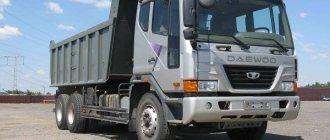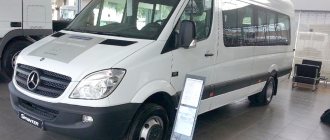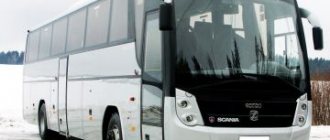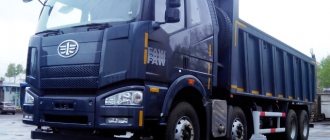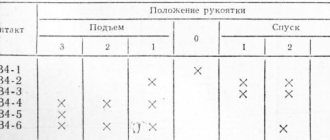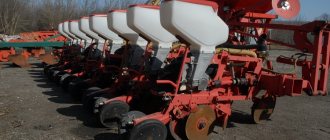City bus Hyundai Super Aero City. Photo Autoimport ST
The Republic of Korea is an economically developed state. Products produced at the country's factories are in demand not only among customers in the Asia-Pacific region, but throughout the world. The use of the latest technologies allows enterprises to produce equipment and machines with a wide range of advantages . Korean buses are no exception. The advantages and disadvantages, popular brands and models of commercial vehicles from Korea are presented below.
A little history
In the middle of the last century, with the assistance of the USSR, the FAW (First Automobile Works) automobile plant was opened in Beijing (PRC), producing passenger cars. Since then, the domestic auto industry has begun to develop in China. Production at the enterprise started with the production of Hongqi cars for high-ranking officials.
Today, China occupies a leading position in the global car market. China, together with foreign partners, creates about 10 million cars a year. There are more than a dozen automobile factories in the country.
At the beginning of this century, minivans began to be produced in China - compact, roomy vehicles. At the moment, such models continue to gain popularity.
Chinese minivans
On average, minivans have 7 seats. The cars are single-volume. The car is suitable for a family or friends trip.
Chinese cars are competitive due to their good configuration and appearance. In most cases, vehicles can be purchased at an affordable price.
Geely Emgrand EV 8
The minivan, made in China, seats 8 people. The car was first presented to the public in 2009 as a concept, and in 2014 it appeared on the market.
- height 1.75 m, width – 1.83 m, length – 4.80 m;
- maximum speed – 150 km/h;
- engine – 2.0 liters (4 cylinders), power – 140 horsepower (hp).
Geely Emgrand EV 8 consumes up to 10 liters of 92 gasoline per 100 km. For such models the indicator is low. The spacious trunk – with the seats folded down – is 3000 liters.
Front airbags are not installed as standard. The car has a comfortable driver's seat and plenty of space in the rear seats. The developers have equipped the vehicles with modern technologies. The automatic transmission has 6 steps.
Price from approximately 800 thousand rubles.
Chery Cross Eastar
The Chinese introduced the Chery B14 concept car to their lineup in 2004. After 2 years of improvement, the seven-seater station wagon was put into mass production. The Chery Cross Eastar appeared on the Russian market in 2008. The minivan is also called a large crossover.
Station wagons have stopped being supplied to the Russian Federation since 2012. All remaining cars were sold within 2 years.
- height – 1.60 m, width – 1.82 m, length – 4.66 m;
- maximum speed – 185 km/h;
- engine – 1.8 l (4 cylinders), power – 125 hp.
The cabin has 3 rows of seats. "Chery" is equipped with a 5-speed manual transmission. Fuel consumption on the highway is 6.2 liters, and in the city – 10 liters. The wheelbase is 2.65 m.
The car has an audio system, an on-board computer and 2 front airbags.
Such cars were imported to Russia at a cost of 620 thousand rubles.
Chery Karry (A18)
The car was first introduced in 2006. At the exhibition the car was presented as a police car. Serial production started in 2007. The car is not supplied to the Russian car market. Drivers can buy the specified model in Ukraine.
Chery Karry (A18) – passenger, 7-seater car with 3 rows. Main characteristics:
- height – 1.85 m, width – 1.70 m, length – 4.60 m;
- maximum speed – 141 km/h;
- engine – 1.6 l (4 cylinders), power – 94 hp.
Gearbox – 5-speed manual. Fuel consumption: city – 9 l/100 km, highway – 7.5 l/100 km. Load capacity – 650 kg.
Vans have different configurations and, accordingly, prices. The car was produced in 2008/09 and has an alarm system and air conditioning. Price is approximately from 280 to 430 thousand rubles.
Baojun 730
The brand was introduced back in 2010, and launched into production in 2014. After 36 months, the car was updated and now produces 5, 7 and 8 seater cars.
Baojun 730 is a new compact van (made on the basis of a compact-class car). The car has a touch screen. The steering wheel is power-assisted and the suspension is completely independent. The car also has climate control and a rear view camera.
Baojun 730 is comfortable and technologically savvy. The car is sold with 2 types of engines.
- height – 1.75 m, width – 1.82 m, length – 4.78 m;
- maximum speed – 150 km/h;
- engine – 1.5 l (4 cylinders), power – 150 hp.
Kia Pregio / Kia Pregio
Another company that produces minibuses is Kia, which produces models called Pregio.
This Korean minibus was released in 1996. In 2003, the minibus was modernized. The Kia Pregio is available in passenger, utility and cargo versions. Like most minibuses, this car is available with a standard and extended body. Passenger versions of these minibuses are available with different numbers of seats for passengers. There are versions with 9, 12 and 15 seats. Cargo-passenger versions are designed for 3 and 6 passengers. The standard version of the minibus is 4.9 meters long, the length of the car with an extended body is 5.55 meters, but their width and height are the same: the width is 1.81 meters, the height is 1.98 meters. The Kia Pregio minibus, produced since 2003, received a wide range of diesel power plants with different powers and volumes. The minibus can be equipped with one of two 2.7-liter engines producing 80 hp. The only difference between these engines is torque. Engines with volumes of 2.5 and 3.0 liters are also installed on the Pregio. The power of the 2-liter unit is 94 hp, and the 3.0-liter engine develops 85 “horses”.
This Korean minibus can be equipped with a 5-speed manual transmission or a 4-speed robotic gearbox. Automatic transmissions are supplied only to minibuses equipped with 2.7-liter engines. All minibuses are driven by rear wheels.
Minibuses
Chinese minibuses often accommodate more passengers than minivans. New vehicles have excellent design and continue to improve. The cost of minibuses from the Middle Kingdom is much less than that of Europeans and Americans.
The Chinese are trying to create comfortable transport. Several configurations are available for sale. Many features (from electrical equipment to audio system) are available in standard quantities.
Some models are perfect for intercity transportation. On the Russian market, the Chinese manufacturer is popular due to its price-quality ratio.
Wuling Xingwang
The car has been produced since the mid-2000s. Wuling Xingwang has 8 seats and 3 rows. The salon has a pleasant finish. Well suited for family trips as an SUV.
- height about 1.90 m, width reaches 1.45 m, length 3.50 m;
- maximum speed – 98 km/h;
- engine – 1.1 l (4 cylinders), power 52 hp.
These minibuses represent the 1st generation. More powerful models are now being produced. The vehicle is equipped with a manual transmission (4 speeds), air conditioning, car radio and full electrical accessories. The car can be unlocked remotely. The body takes on a streamlined shape. Minibuses are famous for their reliability and efficiency.
Foton View S
Several years ago, China began producing its own copy of the Japanese car “Toyota Hicace” - “Foton View S”. The creators were inspired by the appearance of the original.
A minibus is called a mini SUV. Unlike conventional 16-seater buses, the new S-models can accommodate 6 passengers.
The interior is not as high quality as the original: there is plastic and leatherette.
- height – 2.28 m, width – 1.92 m, length – 5.38 m;
- maximum speed – 160 km/h;
- engine – 2.4 l (4 cylinders), power 136 hp.
The engines are divided into gasoline and turbodiesel (2.8 liters), operating on a five-speed gearbox. Wheelbase – 3.10 m.
Despite the fact that the Chinese took the design idea from their Japanese colleagues, the interior is not of such quality. The seats are upholstered in polymer material, and instead of wood there is plastic.
This vehicle is suitable for taxi drivers and travel agencies.
Cost – about 860 thousand rubles.
Groz Polarsun
The Chinese manufacturer borrowed the idea from the Japanese and created the Groz Polarsun minibus based on the template. The latter was brought to the characteristics of the Toyota Hiace (2005).
The new Chinese minivan is constantly being improved. At home, passenger and freight transport options have been in great demand for several years in a row.
Depending on the year of manufacture of the minibus, the number of seats varies. The transport can accommodate 9 passengers.
- height 2 m, width 1.7 m, length 5 m;
- maximum speed – 120 km/h;
- engine 2.6 l (4 cylinders), power 105 hp.
Average fuel consumption is 12l/100 km. The driver has an excellent overview. There are 3 rows in the cabin. The seats are covered with velor. When loaded, the ride becomes softer.
From the outside you can see the similarity with the original car.
Cost from 400 thousand rubles.
Brands of models from Korea and their purpose
a fairly extensive list of enterprises on the Korean bus production market . The products of each company are distinguished by their individual characteristics; certain technologies are used in their production. As a result, the buyer gets the opportunity to purchase a model with any parameters . The most famous brands, as well as the range of equipment they produce, are presented and analyzed below.
KIA
KIA Motors Corporation is an automobile manufacturing company founded in 1944. It is the second largest manufacturer of cars, trucks, and SUVs in the Republic of Korea and the seventh largest in the world. The range also includes buses. The company produces models of various classes and purposes: small, medium and large; urban, suburban and intercity.
Tourist bus Kia Granbird Silkroad. Photo Autoimport ST
A significant part of the cars are assembled on the basis of analogues of well-known Japanese companies : HINO, Mazda, Toyota. Buses are characterized by reliability, long service life, modern design, and relatively affordable cost. These positive parameters ensure stable high demand in many world markets.
Ssang Yong
SsangYong Motor Company is an engineering company, the fourth largest automobile manufacturer in Korea, headquartered in Seoul. Since the 1990s, the company has been part of the Daewoo concern. At different times, trucks, buses and special equipment rolled off the production lines of the enterprise.
SsangYong Transtar bus. Photo Wikipedia
Passenger transport for tourist and intercity purposes is popular in the homeland. Despite good performance characteristics, compliance with the standards and requirements of customers from different countries, SsangYong equipment has not gained much popularity in Russia.
Hyundai
Hyundai Motor Company is the largest automaker in the country and the fourth largest in the world, producing passenger cars, minivans and commercial vehicles for transporting passengers. The Hyundai Motor division specializes in the production of buses. The division has been producing a diverse range of models : from extra small to large class - since 1967.
Tourist (excursion) bus Hyundai Universe with a capacity of 43+1. Photo YarCamp
Buses are in high demand, including among Russian carriers, due to their compromise price-quality ratio . In addition, the models are unpretentious and economical to operate, quickly pay for themselves, are characterized by increased comfort, and are characterized by confident and reliable operation even in the harshest conditions.
Daewoo Bus
Daewoo Bus is one of the largest machine manufacturers in the Republic of Korea. The company is engaged in the development, production and sale of buses of various classes . The company has several factories located in the homeland of the plant and abroad. The history of Daewoo Bus began in 2002. However, the company's predecessor, Shinjin Motors, was formed in 1955 and has changed its name several times since then. As a result, in the early 2000s the company acquired its current name. Models of several modifications, capacities and for the implementation of various tasks come out of the assembly line of factories : urban, suburban and tourist, small, medium and large.
Tourist bus Daewoo FX120. Photo Autoimport ST
Daewoo buses are reliable, comfortable for drivers and passengers, and easy to maintain. High build quality , the use of modern technologies and the latest developments in production, and an affordable price allow Korean buses to successfully compete with equipment from well-known European and Japanese brands.
Customer Reviews
Chinese cars presented in the model range often gain popularity after serial production.
Opinions about each minivan and minibus are mixed. Most buyers praise the quality. Drivers note the comfort and equipment. Positive feedback also states that the air conditioners work well. Negative reviews include flimsy bearings, insufficient oil and unreliable climate control.
When purchasing any brand, you should carefully read the ratings of drivers and experts.
Main representatives
The most suitable price/quality parameters today are minivans from Asian countries, including Korea. We invite you to get acquainted with the most striking examples of Korean family cars that can be found on the Russian car market today.
Video about the Hyundai Matrix car:
Hyundai Matrix
The five-seater minivan was produced between 2001 and 2005, and today it can be found on the secondary car market. It is built on the basis of a golf car of the same name, the engine of which was also located transversely. The minivan is designed for five adults, including the driver: its interior is designed in such a way that each passenger feels as comfortable as possible. For those with a larger build, the first row seats are suitable. They will be comfortable even for those whose height is approaching the two-meter mark, and whose weight has exceeded a hundred kilograms.
The driver's seat is equipped in such a way that the main control buttons can be easily reached. The only thing that may cause discomfort at first is the location of the dashboard: Korean developers have placed it in the center of the front panel, which is why the driver will have to look to the right from time to time, losing sight of what is happening on the road. Thanks to the high seating position and large glass area, the driver receives excellent visibility.
Hyundai Matrix subcompact
At the back of the minivan, the developers placed a row of seats, which are divided in a ratio of 40:60 and can accommodate three passengers. The amount of space above your head allows even the tallest people to sit comfortably, and if necessary, the sofa can be moved back along the guides and get a little more legroom. You can move the entire row forward or backward, as well as individual seats. It is also worth noting that the angle of the backrests is adjustable.
The minimum trunk size is only 350 liters. This is due to the overhangs being too short. If you fold the last row of seats, this figure can be increased to 1285 liters. These minivans were supplied to the global car market from Korea in several trim levels. For Europeans, there was a basic version with a 1.6-liter engine with a manual transmission, which included side and front airbags, ABS, power accessories for windows and mirrors, central locking, foglights and audio preparation. A minivan with a 1.8-liter engine received air conditioning and an on-board computer in addition to everything listed above. The buyer could additionally order 4 automatic transmission.
On the Russian market there was a version with a 1.6-liter engine, equipped with air conditioning and a driver's airbag, but without ABS. The 1.8-liter engine already came with ABS and heated front seats. On the road, the minivan demonstrates good dynamics and handling.
Hyundai Matrix interior
SsangYong Stavic
The first generation minivans, produced between 2004 and 2010, cannot boast of high sales figures due to their not very presentable appearance. They managed to occupy a small niche in the Russian car market, but the situation changed with the arrival of a new generation representative from Korea in 2013. Its appearance has undergone radical changes, while maintaining the inherent features of the brand.
The secret of the attractiveness of the new version of Stavic lies in the smooth lines of the body, decorated with soft wave-like stampings. As has become fashionable recently, its front part is similar in appearance to a crossover: large headlight shades frame a radiator grille made in a strict geometric shape. There is a massive front bumper, on the sides of which there are recessed fog lights. From behind, the minivan looks no less stylish due to the rectangular door with glazed original shape, miniature bumper and rear lights.
SsangYong Stavic - a modern family car
The spacious interior can be transformed, conveniently placing passengers in the second and third rows of seats, or freeing up the space necessary for luggage. The driver's seat is equipped with an ergonomic seat; the front console houses an instrument panel with all the necessary sensors and buttons.
The manufacturer offers minivans for sale in three trim levels: the basic Luxury Touring, the mid-range Grand Touring and the top-end Royal Touring. The basic version is distinguished by a set of the most necessary options, thanks to which the trip turns into an exciting and comfortable journey. Among the engines, buyers have access to 3.2-liter gasoline power units (220 hp) and 2-liter diesel engines (149 hp). A diesel engine is equipped with a 6-speed manual transmission or a 5-speed automatic transmission, but a gasoline engine comes only with automatic transmission.
SsangYong Stavic car interior
Kia Carnival
Each of us has more than once noticed these nimble Korean cars with a recognizable silhouette on the city streets. The first model rolled off the assembly line back in 1998, and in the summer of 2014, at the New York Auto Show, the manufacturer presented the third generation of the car to the public.
The first and second generation models have a characteristic appearance that can hardly be called ideal. However, this did not prevent the car from finding its buyer, and now, when such a professional as Peter Schreyer took part in the design development, the third generation minivan received a stylish appearance that is quite capable of competing with cars of a higher class.
Minivans of this line can accommodate 7 people including the driver. The transformation allows you to free up space for luggage or comfortably accommodate passengers in the third row by moving it slightly forward or back (depending on your needs). This row, like the next one, can be folded, increasing the trunk volume to the maximum. The first generations of Carnival for the European market were equipped with a 2.5-liter V6 petrol or a 2.9-liter diesel engine. Developers from Korea offered American car enthusiasts a powerful 3.5-liter V6. The engines are equipped with 5 manual transmission or 4 automatic transmission. The minivan demonstrates good stability, handling and dynamics, making it popular as a car for family and business trips.
Advantages and disadvantages of models from South Korea
The Korean automobile industry occupies one of the leading positions on the world stage. Equipment from manufacturers from South Korea is distinguished by its reliable design, high working life, the use of modern solutions, and an optimal quality-price ratio . Modern and comfortable models are supplied in various configurations , which allows you to choose the right option for organizing passenger transportation in the suburban area, making excursions, carrying out long long journeys, and moving along busy city roads.
Suburban bus Daewoo BS090. Photo AltaiBusinessAuto
The models are maneuverable, safe, and stable on roads with different types of surfaces. The passenger compartment and driver's cabin are equipped with everything necessary for comfortable travel and high-quality performance of your duties. The equipment is capable of working in intensive mode , and it is also perfectly suited for use on Russian roads. A bus from Korea is a suitable vehicle option for large transport companies, individual entrepreneurs and private buyers.
The disadvantages of equipment from Korea should be noted:
- The production of high-quality models began relatively recently, since the mid-2000s; the bus manufacturing industry in Korea is quite young, which may demonstrate some technical imperfections.
- Korean equipment is inferior in quality to some manufacturers, for example, Japanese and German.
